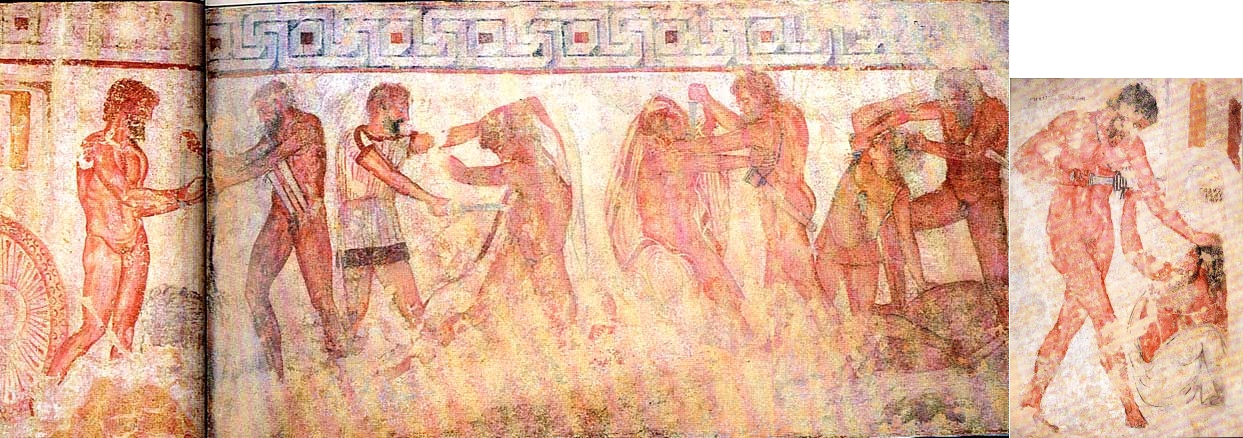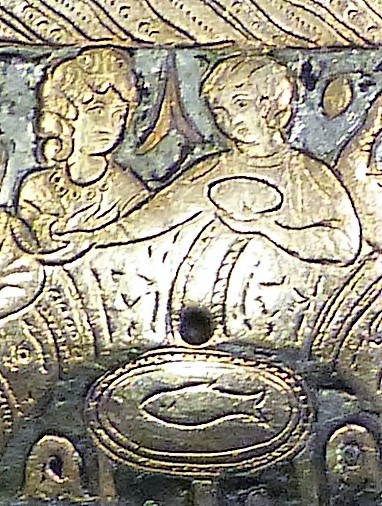|
Zoticus (husband Of Elagabalus)
Aurelius Zoticus (Greek: Αύρήλιος Ζωτικός; active c. 219 – 221) was a ''cubicularius'' and famous male lover of the young Roman emperor Elagabalus. His story is known in two versions, one told by Cassius Dio and one contained in the later ''Historia Augusta''. Version of Dio The contemporary historian Dio tells that Aurelius Zoticus was an athlete originally from Smyrna, the son of a cook, for which he had the nickname Mageiros ("cook"). In addition to having a beautiful body, Zotico was known for having large sexual organs; when the emperor's envoys, sent around for this purpose, learned of this fame, they had him accompanied to Rome with a gigantic escort. In the capital he received the title of cubicularius, (attendant to the emperor's bedroom), obtained the honor of bearing the name Avitus (which belonged to Elagabalus' grandfather, Gaius Julius Avitus Alexianus), was adorned with garlands and brought to the imperial palace accompanied by many torches. Elag ... [...More Info...] [...Related Items...] OR: [Wikipedia] [Google] [Baidu] |
Cubicularius
''Cubicularius'', Hellenized as ''koubikoularios'' (), was a title used for the eunuch chamberlains of the imperial palace in the later Roman Empire and in the Byzantine Empire. The feminine version, used for the ladies-in-waiting of the empresses, was ''koubikoularia'' (κουβικουλαρία). History The term derives from their service in the ''sacrum cubiculum'', the emperor's "sacred bedchamber". In the late Roman period, the ''cubicularii'' or ''koubikoularioi'' were numerous: according to John Malalas, Empress Theodora's retinue numbered as many as 4,000 '' patrikioi'' and ''koubikoularioi''.. They were placed under the command of the '' praepositus sacri cubiculi'' and the ''primicerius sacri cubiculi'', while the other palace servants came either under the '' castrensis sacri palatii'' or the ''magister officiorum''.. There were also special ''cubicularii''/''koubikoularioi'' for the empress (sometimes including female ''koubikoulariai''), and the office was intr ... [...More Info...] [...Related Items...] OR: [Wikipedia] [Google] [Baidu] |
Roman History
The history of Rome includes the history of the Rome, city of Rome as well as the Ancient Rome, civilisation of ancient Rome. Roman history has been influential on the modern world, especially in the history of the Catholic Church, and Roman law has influenced many modern legal systems. Roman history can be divided into the following periods: *Pre-historical and early Rome, covering Rome's earliest inhabitants and the legend of its founding by Romulus and Remus, Romulus *The Etruscan civilization, period of Etruscan dominance and the Roman Kingdom, regal period, in which, according to tradition, Romulus was the first of seven kings *The Roman Republic, which commenced in 509 BC when kings were replaced with rule by elected magistrates. The period was marked by vast expansion of Roman territory. During the 5th century BC, Rome gained regional dominance in Latium. With the Punic Wars from 264 to 146 BC, ancient Rome gained dominance over the Western Mediterranean Sea, Mediterranea ... [...More Info...] [...Related Items...] OR: [Wikipedia] [Google] [Baidu] |
LGBTQ History In Italy
This article is about lesbian, gay, bisexual, transgender, and queer (LGBTQ) history in Italy. BCE * 5th millennium BC - Examples of homosexual eroticism in Upper Paleolithic or Mesolithic European art in Sicily. In Addaura incision is a group of people dancing around two men, both with erections, possibly indicating a homoerotic ritual. *530 BC – One of the earliest examples of Etruscan art on homosexuality, found in 1892 in the Necropolis of Monterozzi near Tarquinia. The painting, situated in what has been called the Tomb of the Bulls (Italian: ''Tomba dei Tori''), depicts on the right a bull with a man's face (Achelous, Acheloos) and an erect phallus that is aggressively approaching two men having sexual intercourse. On the left, another bull is turned around, as though indifferent, in front of men and women having sexual intercourse. The women are consistently depicted in light tones, while the men are brown. Under the frieze is Achilles (on the left) waylaying Troilus. ... [...More Info...] [...Related Items...] OR: [Wikipedia] [Google] [Baidu] |
Italian Gay Men
Italian(s) may refer to: * Anything of, from, or related to the people of Italy over the centuries ** Italians, a Romance ethnic group related to or simply a citizen of the Italian Republic or Italian Kingdom ** Italian language, a Romance language *** Regional Italian, regional variants of the Italian language ** Languages of Italy, languages and dialects spoken in Italy ** Italian culture, cultural features of Italy ** Italian cuisine, traditional foods ** Folklore of Italy, the folklore and urban legends of Italy ** Mythology of Italy, traditional religion and beliefs Other uses * Italian dressing, a vinaigrette-type salad dressing or marination * Italian or Italian-A, alternative names for the Ping-Pong virus, an extinct computer virus * ''Italien'' (magazine), pro-Fascist magazine in Germany between 1927 and 1944 See also * * * Italia (other) * Italic (other) * Italo (other) * The Italian (other) * Italian people (other) Italian ... [...More Info...] [...Related Items...] OR: [Wikipedia] [Google] [Baidu] |
Husbands Of Roman Emperors
A husband is a man involved in a marital relationship, commonly referred to as a spouse. The specific rights, responsibilities, and societal status attributed to a husband can vary significantly across different cultures and historical periods, reflecting a global perspective on this role. In many parts of the world, heterosexual monogamous marriage is the prevailing norm, where a husband and wife form the basic unit of a family. Legal systems in numerous countries enforce monogamy and prohibit bigamy and polygamy. Traditionally, husbands often held the position of being the head of the household and the primary provider, a role that was often considered paternalistic. However, the evolving dynamics of modern society have led to a shift in these roles. Today, a husband is not automatically designated as the sole breadwinner, especially when his spouse pursues a more financially rewarding career. This change reflects a global trend in the changing dynamics of gender roles an ... [...More Info...] [...Related Items...] OR: [Wikipedia] [Google] [Baidu] |
Ancient Smyrnaeans
Ancient history is a time period from the beginning of writing and recorded human history through late antiquity. The span of recorded history is roughly 5,000 years, beginning with the development of Sumerian cuneiform script. Ancient history covers all continents inhabited by humans in the period 3000 BCAD 500, ending with the expansion of Islam in late antiquity. The three-age system periodises ancient history into the Stone Age, the Bronze Age, and the Iron Age, with recorded history generally considered to begin with the Bronze Age. The start and end of the three ages vary between world regions. In many regions the Bronze Age is generally considered to begin a few centuries prior to 3000 BC, while the end of the Iron Age varies from the early first millennium BC in some regions to the late first millennium AD in others. During the time period of ancient history, the world population was exponentially increasing due to the Neolithic Revolution, which was in full prog ... [...More Info...] [...Related Items...] OR: [Wikipedia] [Google] [Baidu] |
Ancient Roman LGBTQ People
Ancient history is a time period from the History of writing, beginning of writing and recorded human history through late antiquity. The span of recorded history is roughly 5,000 years, beginning with the development of Sumerian language, Sumerian cuneiform script. Ancient history covers all continents inhabited by humans in the period 3000 BCAD 500, ending with the Early Muslim conquests, expansion of Islam in late antiquity. The three-age system periodises ancient history into the Stone Age, the Bronze Age, and the Iron Age, with recorded history generally considered to begin with the Bronze Age. The start and end of the three ages vary between world regions. In many regions the Bronze Age is generally considered to begin a few centuries prior to 3000 BC, while the end of the Iron Age varies from the early first millennium BC in some regions to the late first millennium AD in others. During the time period of ancient history, the world population was Exponential growth, e ... [...More Info...] [...Related Items...] OR: [Wikipedia] [Google] [Baidu] |
3rd-century Romans
The 3rd century was the period from AD 201 (represented by the Roman numerals CCI) to AD 300 (CCC) in accordance with the Julian calendar. In this century, the Roman Empire saw a crisis, starting with the assassination of the Roman Emperor Severus Alexander in 235, plunging the empire into a period of economic troubles, barbarian incursions, political upheavals, civil wars, and the split of the Roman Empire through the Gallic Empire in the west and the Palmyrene Empire in the east, which all together threatened to destroy the Roman Empire in its entirety, but the reconquests of the seceded territories by Emperor Aurelian and the stabilization period under Emperor Diocletian due to the administrative strengthening of the empire caused an end to the crisis by 284. This crisis would also mark the beginning of Late Antiquity. While in North Africa, Roman rule continued with growing Christian influence, particularly in the region of Carthage. In Persia, the Parthian Empire was s ... [...More Info...] [...Related Items...] OR: [Wikipedia] [Google] [Baidu] |
Erectile Dysfunction
Erectile dysfunction (ED), also referred to as impotence, is a form of sexual dysfunction in males characterized by the persistent or recurring inability to achieve or maintain a Human penis, penile erection with sufficient rigidity and duration for satisfactory sexual activity. It is the most common sexual problem in males and can cause psychological distress due to its impact on self-image and sexual relationships. The majority of ED cases are attributed to physical risk factors and predictive factors. These factors can be categorized as vascular, neurological, local penile, hormonal, and drug-induced. Notable predictors of ED include aging, cardiovascular disease, diabetes mellitus, Hypertension, high blood pressure, obesity, Dyslipidemia, abnormal lipid levels in the blood, hypogonadism, smoking, Depression (mood), depression, and Adverse drug reactions, medication use. Approximately 10% of cases are linked to psychosocial factors, encompassing conditions such as depressio ... [...More Info...] [...Related Items...] OR: [Wikipedia] [Google] [Baidu] |
Hierocles (charioteer)
Hierocles (, late 2nd century – 222 AD) was a favourite and lover of the Roman Emperor Elagabalus. Most of the descriptions of his life are given by Cassius Dio and the ''Historia Augusta''. Hierocles was from Caria in Anatolia, and was at some point enslaved, later becoming a charioteer in the service of Elagabalus. Initially, he was a lover and student of another charioteer named Gordius. Elagabalus was said to have been captivated by the blond and youthful Hierocles when the athlete fell in front of him during a chariot race. The Emperor made him his lover and husband and, as a consequence, Hierocles was alleged to have gained significant political influence. Additionally, Hierocles' mother, a slave, was promoted to be equal among wives of ex-consuls. Hierocles banished the Emperor's other lover, athlete Aurelius Zoticus, and inflicted physical violence upon Elagabalus when the latter was unfaithful. After Elagabalus granted Hierocles his freedom, he wanted Hierocles to ... [...More Info...] [...Related Items...] OR: [Wikipedia] [Google] [Baidu] |






